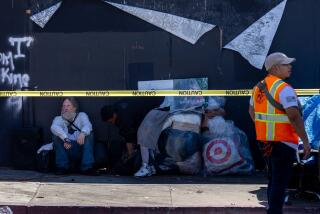Homeless Could Lose Beds Today
- Share via
Every year as winter fades to spring, homeless shelters throughout Los Angeles County shut their doors. The emergency network of 19 shelters can afford to operate only during the cold, rainy winter season.
But this year, amid a difficult economy and a police crackdown on homeless encampments on downtown’s skid row, the closure promises to be especially painful and problematic.
Shelter operators report that their facilities are overflowing. As a result, nearly 1,000 people, including families with small children, will have to find somewhere else to sleep when the shelters close today.
“This is the worst I have ever seen it. We’ve been turning people away on a nightly basis,” said Harrison Soberanis, executive director of People Helping People, which runs a winter shelter in South Los Angeles.
The seasonal shelters provide about 2,100 beds, more than half of them within Los Angeles city limits. This year, city officials extended the winter shelter program, which normally ends March 15, an extra month to accommodate the high demand. But the extension covers just nine shelters, with a total of 860 beds. Shelter managers say they have been cramming in extra cots to hold more people.
In an 11th-hour effort to keep those shelters open, Councilwomen Jan Perry and Wendy Greuel last week asked the City Council to fund the facilities for another month. The council will consider the request today.
Barring council action, those beds would disappear and some homeless people who rely on them say they will have no choice but to camp out on sidewalks or under freeway overpasses. Such a move threatens to complicate the new effort to clean up skid row, a priority of Mayor James K. Hahn and Los Angeles Police Chief William J. Bratton.
“It’s inhumane,” said Kevin Johnson, 32, a day laborer staying at First Step Emergency Shelter in downtown Los Angeles. “How are you going to tell me I can’t sleep on the streets when you ain’t got no bed for me?”
On the streets of skid row -- from 3rd to 7th streets between Main and Alameda streets -- thousands of homeless people have been rousted from their usual routines in recent months. Many of the tents and tarps are gone, but that doesn’t mean the people who huddled there have vanished.
While many have moved into shelters, hundreds more have migrated into nearby neighborhoods. At an April 1 meeting of the Downtown Los Angeles Neighborhood Council -- a crowded session attended by Bratton and Perry -- a man said that the arts district near Santa Fe Avenue and 4th Street was being inundated by homeless people.
“There are 250 people living under the 4th Street Bridge,” he said, adding that car break-ins, muggings and drug activity have increased. Perry, who represents the area, promised to reinstall a fence near the bridge.
Other homeless people who once roamed skid row are in jail. In November, state and local law enforcement teams swept through the area searching for parole violators. They arrested more than 200 people.
About the same time, Bratton chose skid row as one of three areas to test his crime-fighting strategy that tackles low-level offenses as a means of preventing more serious crimes.
In the last year, police began to enforce a city law against sitting, lying or sleeping on a public sidewalk and arrested more than 860 people in the skid row area, according to LAPD records.
“The word got around,” said Sgt. James MacDonald, who runs the detail that patrols skid row. “We tried to warn them: ‘If I see you again, I’m going to come back and arrest you.’ ”
A court order issued earlier this month put a temporary stop to indiscriminate police sweeps in search of parole and probation violators. But police said they are still enforcing the city law against sleeping on public sidewalks.
As MacDonald cruised down Towne Avenue on a recent morning, several homeless men took one look at the police car and shuffled off in the opposite direction.
“How come you guys are out here?” MacDonald called out the window to two people still sitting on the sidewalk.
“I don’t know,” one said warily without budging from his lawn chair.
“The law’s still in effect. You cannot sit, sleep or lie on the sidewalk,” the sergeant said.
As the city encourages downtown development with artist lofts and other projects, Perry went to the county Board of Supervisors in February to plead for money to keep the 19 shelters open year-round at a cost of $9 million.
A few weeks later Hahn, Bratton and Perry held a news conference at a downtown shelter to scold the county for “falling short” in its spending on homeless programs.
So far, supervisors have not responded to the city’s challenge.
County officials say the county is already pulling its financial load when it comes to homeless services. In a report to the Board of Supervisors, Carlos Jackson, director of the Community Development Commission, defended the county’s shelter services in downtown Los Angeles as part of a $132-million effort focused on helping needy people countywide move toward independent living.
“The chronic homeless population in downtown Los Angeles is but one part of the housing and service needs throughout the county,” Jackson wrote. He did not recommend new funding for the winter shelter program.
If the shelters close, hundreds of people are likely to pour back onto skid row streets.
“Ain’t nowhere else to go,” said Joseph Bunville, 49, a homeless man staying at the First Step shelter. “They’ll just have to fix us a bed up in the jail, then, won’t they?”
More to Read
Sign up for Essential California
The most important California stories and recommendations in your inbox every morning.
You may occasionally receive promotional content from the Los Angeles Times.













